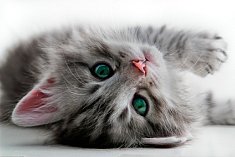|
Feline Eye Infection: Causes, Symptoms, Treatments

Feline eye infections can be a painful cat health problem with several different causes and symptoms. Eye infections tend to occur more often in cats with a compromised or weaken immune system, such as cats that are ill. Senior cats and kittens are also more susceptible to contracting eye infections. There are three different types of eye infections that affect cats: viral, bacterial and fungal. Each type of eye infection has their own set of characteristics that aid veterinarians in both diagnosing and treating the infection.
Viral Feline Eye Infections
One of the most common causes of feline eye infections is feline herpesvirus-1, which is a viral infection. Most common symptoms are redness and swelling of the affected eye or eyes, squinting, watery or greenish discharge, a dull or cloudy iris, excess tear production out of the infected eye and inflammation and soreness of the cornea. Eye infections that are caused by feline herpes cannot be cured, only suppressed. As a result of the inability to cure this illness, your cat may experience occasional outbreaks, especially during times when your cat is stressed or sick. Other viruses that can cause eye infections include feline immunodeficiency virus, feline infectious peritonitis and feline panleukopenia. Feline immunodeficiency virus can be transmitted through cat bites. Similar to HIV and AIDS in humans, the disease weakens the immune system and allows for other illnesses and infections to easily enter your cat's system and dominate. Symptoms of this illness include weight loss, diarrhea, skin infections, lethargy, dental health problems and fever.
Feline infectious peritonitis is caused by a virus called coronavirus. Although medication is used to improve quality of life by decreasing pain and discomfort, this illness is usually fatal and is currently not curable.Diagnosis is difficult to reach, but veterinarians conduct several different tests to display the presence of the virus. Symptoms of this illness start off with flu like symptoms such as sneezing, watery eyes, discharge from the nose. Symptoms may then progress into weight loss, loss of appetite, behavioural changes, and a rough dry coat.
Feline Panleukopenai is a highly contagious virus, which mostly infects kittens, due to their weaker immune system. The symptoms of this illness includes vomiting, diarrhea, loss of appetite, behavioural changes and a dull dry coat. Vaccination helps to reduce the chances of your cat contacting this illness.
Bacterial Feline Eye Infections
Bacterial feline eye infections are usually caused by chlamydiosis, which is a mild but chronic upper respiratory disease. Kittens and cats that reside in shelters are highly susceptible to Chlamydiosis. The symptoms of a bacterial infection are identical to symptoms of viral infections of the eye, which includes redness and swelling of the affected eye or eyes, squinting, a dull or cloudy iris, excess tear production out of the infected eye, eye ulcers, and sensitivity to light. It is very difficult for vets to differentiate between viral and bacterial feline eye infection, since the symptoms are very similar. Bacterial eye infections are very contagious and easily transmitted from one cat to the other.
Fungal Feline Eye Infections
Fungal eye infections are extremely rare in cats. Fungal eye infection is often caused by a fungal agent called cryptococcosis. Symptoms specific to this type of feline eye infection includes pupils that do not respond to light, behavioural changes in your cat, dilated pupils, peripheral blindness or an inflamed retina. The presence of these symptoms usually means that the fungus has begun to attack the nervous system and immediate treatment is required.
Treatments
Feline eye infection treatments may vary depending on the cause of the infection. Infections caused by viruses are usually treated with antibiotic ointments. They are used to try and prevent the condition from becoming worse and stopping the symptoms. Oral medication may also be prescribed to get rid of the infection sooner or help prevent it from returning. Antiviral may also be prescribed as a form of treatment when your cat’s cornea is infected. Eye drops can also be administered to reduce pain and dilate the pupil. For severe bacterial eye infections, a vet may prescribe both an oral medication and topical ointment to combat the infection.
When veterinarians experience difficulty differentiating between an eye infection caused by a virus and one caused by bacteria, veterinarians prescribes a drug called tetracycline. Typically, if the infection affects both eyes right away, a virus is the usually the cause. However if the infection only involves one eye or started in one eye and eventually spread to the other, then bacteria is more likely the cause.
For the treatment of the rare eye infections caused by fungus, veterinarians use anti-fungal medication such as fluconazole, trizole, voriconazole or itraconazole. Your cat's veterinarian may recommended that at home you use a warm clean wet cloth to clean discharge from your cat’s eyes. It’s important to use a new clean cloth each day, or you can purchase cat wipes from your local pet store. Since many feline eye infections are highly contagious, you will need to wash your cat’s bedding, blankets and toys, to prevent the illness from spreading to other cats in the house and so that when the eye infection does eventually go away, it won’t easily return
Prevention
There are some preventative measures you can take to lower your cat’s risk of developing a eye infection. Annual necessary vaccinations and a high protein healthy diet both contribute to keeping your cat's immune system strong and your cat healthy. Regular physical examinations may also help to reveal any underlying medical conditions that may later lead to feline eye infections or catch an eye infection in the early stages. Keeping your cat’s eyes clean with a warm cloth or cat wipes is also recommended. Eye infections typically clear up with medication between one to three weeks, depending on the type and severity of the infection.
Similar Topics
Feline Herpes Virus: Causes, Symptoms, Treatments - Discussing the causes, symptoms and treatments of feline herpes virus. Symptoms And Treatments For Diabetes In Cats -How To Identify And Treat Diabetes in Cats.
Common Elderly Cat Health Problems - Discussing several different health problems that affect senior cats and treatment options.
How To Administer Medicine To Your Cat - Several Different Creative Ways To Administer Medication To Your Cat. Choose One That's Right For You And Your Feline Friend.
Cat Flea Treatment- Cat fleas can be both irritating and annoying to your cat, here are some effective flea treatments to get rid of those pesky fleas.
Cat Anatomy: Interesting Facts About Your Cat's Body - Understanding your cat's anatomy will help you better understand your cat. Discussing your cat's senses, body and digestive system.
Return From Feline Eye Infection To Cat Health Home Page
|
Protect Your Pet Card
In Case Of An Emergency The Protect Your Pet Card Lets Emergency Services Know That You Have Pet/Pets Waiting For You At Home, Making Sure That Your Pets Are Cared For.
Get Your Card Today!
Win A Free $250 Petsmart Gift Card For Your Cat!
Must Be A US Resident
Click Here To Easily Enter For Your Chance To Win.

"There are few things in life more heartwarming than to be welcomed by a cat."






